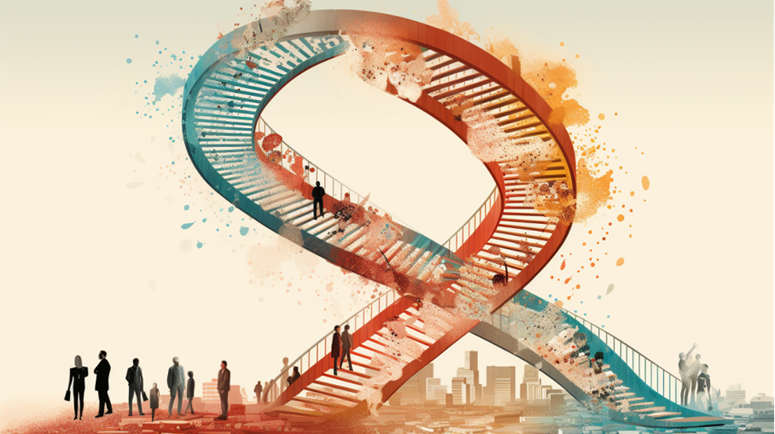Danny Van Quaethem has a master’s degree in Germanic Philology (English-German) at RU Gent. Then he obtained the diploma of financial analyst (ABAF). He wrote for ten years for investment magazines (7 years for Afinas Report and 3 years for De Belegger). In 1997 he started at Société Générale Private Banking Belgium (formerly Bank De Maertelaere). He worked exclusively as a financial analyst covering equity markets, focusing on a number of sectors (pharmaceuticals, chemicals, consumer goods). At Econopolis, Danny is Senior Equity Analyst.
Boom, Bust, and Biotech: A Belgian Stock Market Rollercoaster

Real Estate, Biotech and Naked Swims!
The Belgian stock market is reputed for its Real Estate and Biotech or Medtech companies. Real estate stocks had a glorious ride, sponsored by the ECB’s lenient policies. Ultralow and negative interest rates pushed valuation and earnings higher and so went those stocks. Until the day of reckoning. And it came with a vengeance. Real estate stocks were knocked down by the fast and relentless rise in rates. The tide has gone out and many were discovered swimming naked.
On the other hand, tough times reveal which companies are truly resilient. Once more, quality companies will come out as winners. Quality is the same everywhere. It’s about offering excellent products and services, catering to the needs of clients and making sure your financial house is in order. The latter is often quite problematic for biotech companies. A biotech CFO sometimes looks like a beggar in disguise. A smart CFO will rake in money when he can, not when he needs it. Shrewd investors know they have to watch the cash burn and the runway. When cash runs dry in times like this, it steers companies off the runway into a hard landing.
Argenx Shines Amid Biotech Blues
Belgian investors in real estate stocks have had a tremendous ride. On the way they could cash in fatty dividends. Stocks have returned to earth, but in most cases the intrinsic value has not disappeared. It’s quite another story for biotech investors. Even seasoned professional investors got beaten up black and blue. The Nasdaq biotech index is down 3.5% year-to-date (Nasdaq 100 +39.5% year-to-date) and down about 25% from its peak in August 2021. Specialized international funds like BB Biotech and HBM Healthcare are down 25% and 8% year-to-date, respectively.
Enter Argenx, one of the few bright spots in the bloody biotech mess. At €479, the stock is up about 40% year-to-date. The next best performer in the Bel20 is Solvay (+14%), UCB comes third (+13%). There is one small difference: Argenx’ gains are cumulative, whereas Solvay and UCB are recuperating losses from 2022. Solvay still is down about 15% from its peak in 2015 (!) or 2017. UCB has been on a rollercoaster since 2015 but its share price is a tad below the €84 peak of December 2015 and 28% below its peak reached in April 2022. Solvay has been working hard on a transformation, that will be rounded with a split up of the company. Management hopes this will finally create the value it deserves, at least for the “specialty company”. UCB has been clogged by a stubborn FDA, first unsatisfied with its production unit in Brussels and now simply stalling to approve Bimzelx, its new psoriasis treatment that is expected to become a blockbuster.
The trajectory of Argenx, by contrast, has been stratospheric. It’s IPO dates back to July 2014 when it raised €40 million at €8.50 per share. The stock went up more than 55-fold, a world class performance. Argenx currently has a weight of 17% in the Bel20 (but only 5.6% in the Belgian All share index), far ahead of KBC (11.8%) or AB Inbev (11%), the world’s largest brewer that shrunk itself due to its oversized M&A-hunger. To put things into perspective: Argenx’ enterprise value around €25 billion – that is €28 billion market cap minus roughly €3 billion in cash – is larger than that of Solvay and Umicore combined (around €21 billion). Argenx is not only the bellwether for the Bel20, it also is the darling of international institutional investors. Argenx has a weight of 11,7% in BB Biotech’s portfolio (higher than the weight of Vertex Pharmaceutical at 10.4% or nearly as much as Alnylam Pharmaceuticals and Moderna combined). For HBM Healthcare, Argenx only weighs 4%, but HBM Healthcare has taken some profits on the table earlier on.
Prudent investors warned that the stock has long been priced for perfection. This is one of those very rare occasions where indeed everything remained to be “perfect”. That does not mean everything will continue to go smoothly. In 2018, Argenx entered into an exclusive global collaboration with Johnson & Johnson for the development of cusatuzumab, a promising antibody to treat acute myeloid leukemia. Unfortunately, competition published better data then Argenx and in June 2021 J&J returned the rights to Argenx. A “failure” that stuffed Argenx’ coffers with $500 million ($200 million in equity at €100 per share and a whopping $300 million in cash upfront). When J&J invested $200 million in Argenx, it owned 4.68% of the company. For Argenx the story is not over. In April 2023, it entered a partnership with Genmab to advance antibody therapies in immunology and oncology. It is as if Real Madrid and Manchester City joined forces. However, in biotech there are no guarantees. Even the best teams cannot assure that they will develop a new blockbuster. That is why investors are so keen on Argenx. Sales of Vyvgarth, its new treatment for myasthenia gravis, are expected around €1 billion this year, it’s second year on the market. Furthermore, there are still a lot of clinical readouts in the next 12 to 18 months. Each time, this could add a little value to the company depending on the outcome.
What about the negative impact of higher rates? Argenx has been a master at raising cash. Every time it published strong clinical results, it increased its capital. Argenx could never have raised these incredible amounts of money without the depth of the Anglosaxon capital markets. Its largest shareholders are Fidelity 9.5%, Bailly Gifford 4.6%, Blackrock 3.5% etc. 2023 has been a decisive year for Argenx. After it published outstanding clinical results in the treatment of CIDP it raised cash again. Its latest offering in July filled its coffers with about €1.3 billion. It currently has about €3 billion in cash. Guidance for cash burn is $500 million in 2023. According to consensus the company should become profitable in 2025, with exponential growth in the following years.
We live in extreme “winner takes all” markets. In the old days, sector allocation was a useful tool. These days, performance is sometimes made by just one stock. All big US pharma stock are down year-to-date (Pfizer -30%, Bristol -15%, Abb Vie -10%, J&J -9%), except Eli Lilly. But Lilly is up a whopping 52.7%. Like Novo Nordisk (+41%) in Europe. The sad thing is that the big pharma-winners are thriving on a societal problem: diabetes and its strong link with obesities. In that sense, Argenx is a true pioneer providing healthcare for truly unmet medical needs. Perhaps not surprising, as many big pharma companies filed file a lawsuit against the US government as a reaction to the Inflation Reduction Act (IRA). Novartis filed its case Friday in New Jersey federal court, three days after the Centers for Medicare & Medicaid Services (CMS) revealed that Novartis’ heart failure treatment Entresto was among 10 drugs subject to price negotiations in 2026. Here too, Argenx seems to be “safe”, for the time being, at least. It’s treatment are true innovation for rare diseases and competition is very limited.
Nothing is forever, certainly not high stock prices. Galapagos once was king. In February 2020 its stock reached a high of €250 with a market cap of more than €16 billion only to come crashing down a few weeks later. When the FDA said “njet” to its RA drug filgotinib (Jyseleca) it was game over. Speculators that bought at the top and stuck with the stock face a loss of 86%.
Galapagos so far has only been a would-be champion. Fortunately, previous management used its brilliant negotiation skills to close a mouthwatering deal with Gilead, which “generously” offered some €4 billion in cash. Gilead still is the reference shareholder with 25.35%. Galapagos’ financial report over the first half of 2023 is titled “Forward with a Purpose” (“Doelgericht Vooruit”). Put cynically, the primary purpose might be to turn an ugly duckling into a beautiful swan. The sad truth is that Galapagos had its IPO in 2005, had its moment of glory and now needs to be rebuild from scratch. The contrast with Argenx could not be sharper. The market doesn’t give a dime for Galapagos’ pipeline. In fact, speculators are offered a safety cushion since Galapagos had €3.8 billion cash at June 30th, 2023 whereas its market cap is €2.2 billion. The cash burn in 2023 amounted to €420 million and is expected to amount to €400 million in 2024. That said, Galapagos is expected to buy some companies or in-license molecules so it could become a viable commercial operation. It will be an interesting journey. CEO and Chairman Paul Stoffels and CFO and COO Thad Huston bring their experience as chief Research & Development at J&J and CFO at Kite (Gilead), respectively. They have a deep knowledge of the industry and a huge network. But they don’t have a magic wand. Together with Lonza, Galapagos is trying to revolutionize the CAR-T area. It could become a success, but the road is long and slippery. What the other molecules or business development might bring is even more uncertain. Indeed, Galapagos is the champion of the known unknows.
